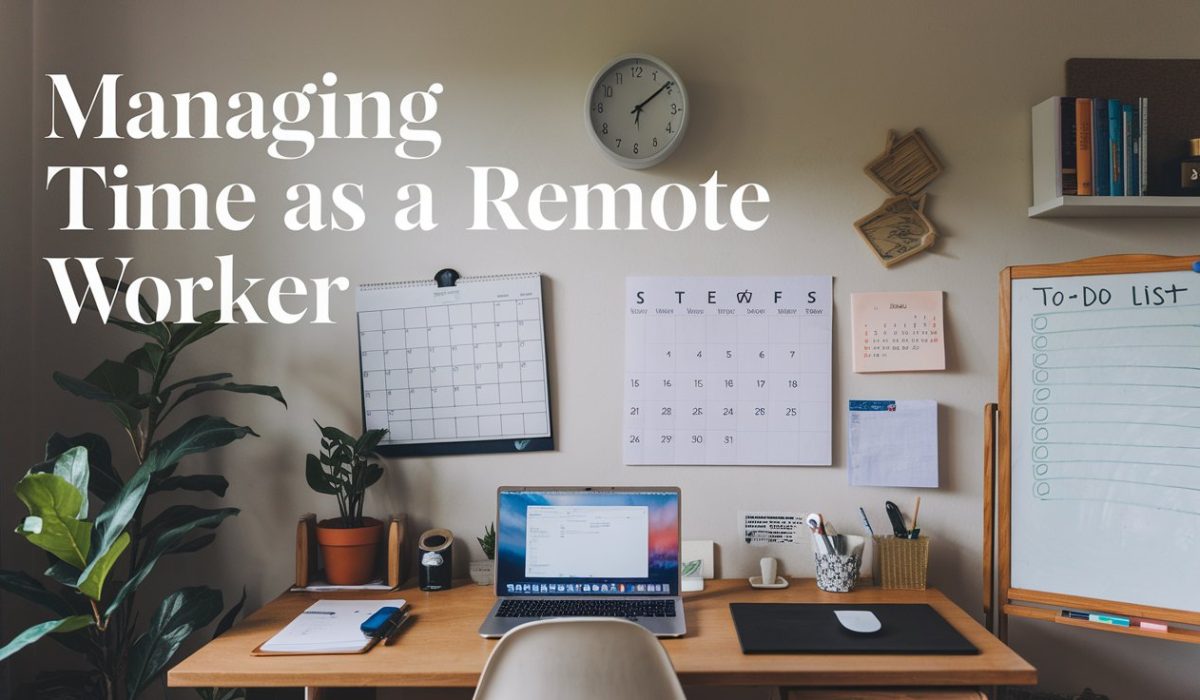Managing Time as a Remote Worker
Remote work offers flexibility and freedom, but it also requires strong time management skills to stay productive. Without a structured office environment, it can be challenging to maintain focus and meet deadlines. Here are some effective strategies to help remote workers manage their time efficiently.
1. Set Clear Goals
One of the best ways to manage your time is by setting clear, achievable goals. Start by outlining your daily and weekly objectives:
- Daily Task List: Break down your workload into manageable tasks and prioritize them. Having a clear list helps keep you focused on what needs to be done each day.
- Weekly Goals: Set larger goals for the week. This allows you to track your progress and adjust your workload as necessary.
- Use Time Blocks: Assign specific blocks of time for each task. This ensures that you stay on track and don’t spend too much time on any one thing.
2. Create a Dedicated Workspace
Having a dedicated workspace can help you establish boundaries between work and personal time:
- Separate Work Area: Set up a specific area in your home where you only do work. This could be a home office, a corner of the living room, or even just a desk. A consistent workspace helps signal to your brain that it’s time to focus.
- Limit Distractions: Keep your workspace free of distractions like television, social media, or household chores. You’ll be more productive when you focus solely on work during designated hours.
3. Stick to a Routine
A routine helps remote workers maintain a sense of normalcy and productivity. Even though you have the flexibility to set your schedule, it’s essential to maintain consistency:
- Set Regular Work Hours: Try to start and end work at the same time each day. This helps establish boundaries between work and personal life.
- Morning Routine: Develop a morning routine to mentally prepare for the day. This could include having breakfast, exercising, or spending a few minutes planning your day.
- End-of-Day Routine: Similarly, create an end-of-day routine to signal the close of your workday. This helps you transition out of work mode and into relaxation.
4. Use Productivity Tools
There are many productivity tools that can help you stay organized and manage your time effectively as a remote worker:
- Task Management Apps: Use apps like Trello, Asana, or Todoist to organize and track your tasks.
- Time-Tracking Tools: Tools like Toggl or RescueTime can help you understand how you spend your time and identify areas where you can improve.
- Calendar Tools: Use a digital calendar like Google Calendar to schedule your tasks, meetings, and personal activities. Block out specific times for work and breaks.
5. Take Regular Breaks
Taking breaks is essential for maintaining productivity and preventing burnout:
- Pomodoro Technique: This time management technique involves working for 25 minutes and then taking a 5-minute break. After four cycles, take a longer break (15-30 minutes). It’s a great way to stay focused without getting overwhelmed.
- Step Away from the Desk: Use your breaks to move around—go for a walk, stretch, or grab a healthy snack. This will refresh your mind and prevent fatigue.
6. Avoid Multitasking
Multitasking can reduce productivity and increase stress. Instead, focus on one task at a time:
- Single-Tasking: Dedicate your attention to one task before moving on to the next. This will help you complete tasks more efficiently and produce higher-quality work.
- Task Prioritization: Use the Eisenhower Matrix to prioritize tasks based on urgency and importance. Focus on what’s critical before tackling less pressing tasks.
7. Communicate Clearly with Your Team
Effective communication is key when working remotely. Clear communication prevents misunderstandings and keeps everyone on the same page:
- Daily or Weekly Check-Ins: Schedule regular check-ins with your team to ensure alignment on tasks and deadlines.
- Use Collaboration Tools: Tools like Slack, Microsoft Teams, or Zoom can help you stay connected with your coworkers. Set clear expectations for when and how you’ll communicate.
8. Learn to Say No
It’s easy to feel like you need to be constantly available when working from home. However, learning to say no to unnecessary tasks or meetings is vital:
- Set Boundaries: Let colleagues know your working hours and communicate when you’re unavailable. Setting clear boundaries helps maintain a healthy work-life balance.
- Prioritize Workload: Don’t hesitate to push back on tasks that don’t align with your priorities or deadlines.
9. Reward Yourself
When you achieve your goals or complete a challenging task, reward yourself. This positive reinforcement can motivate you to stay productive:
- Small Breaks: After finishing a big task, take a short break to relax and recharge.
- Personal Rewards: Treat yourself to something enjoyable after completing a project, such as watching your favorite show or having a special meal.
